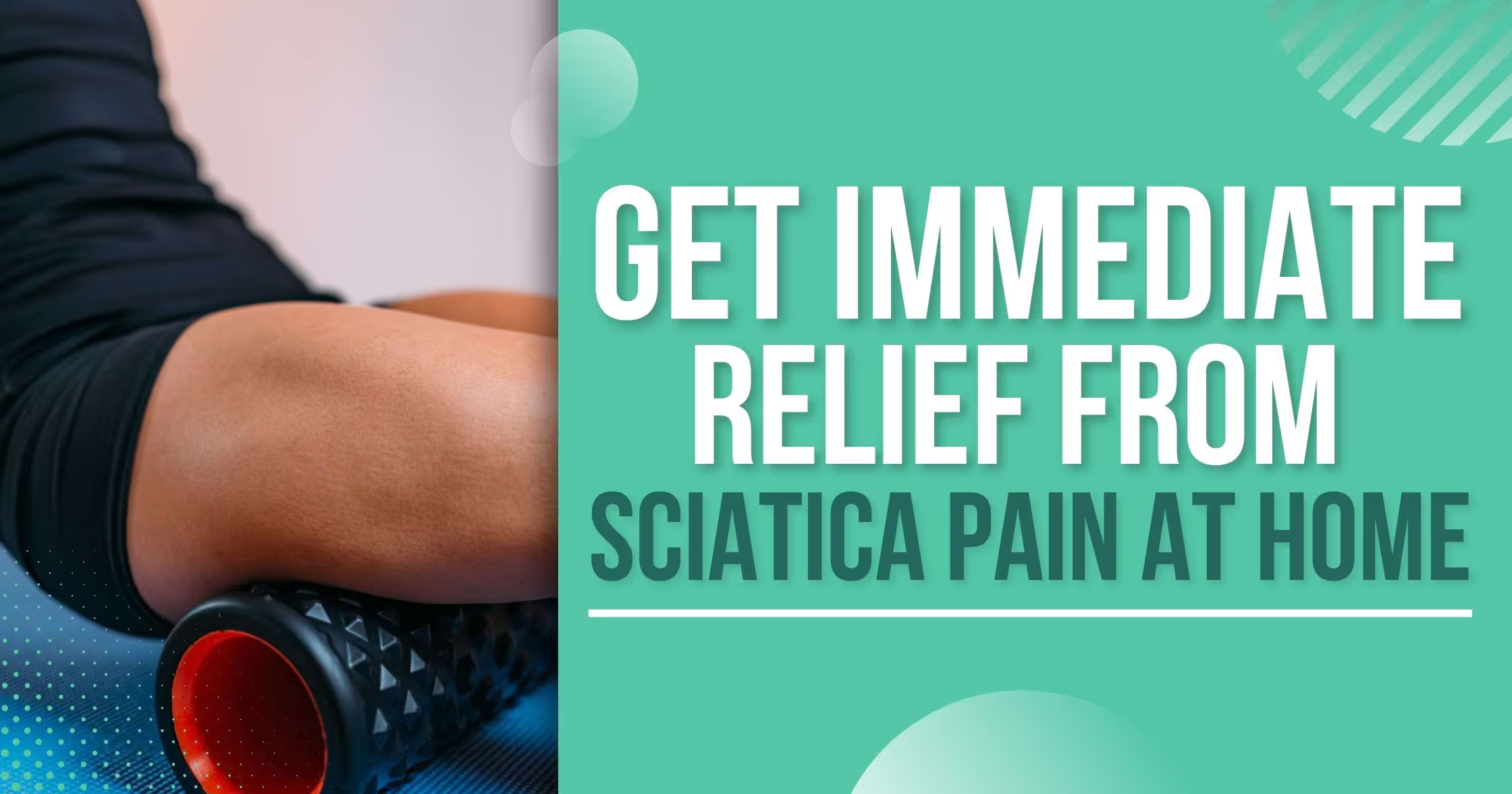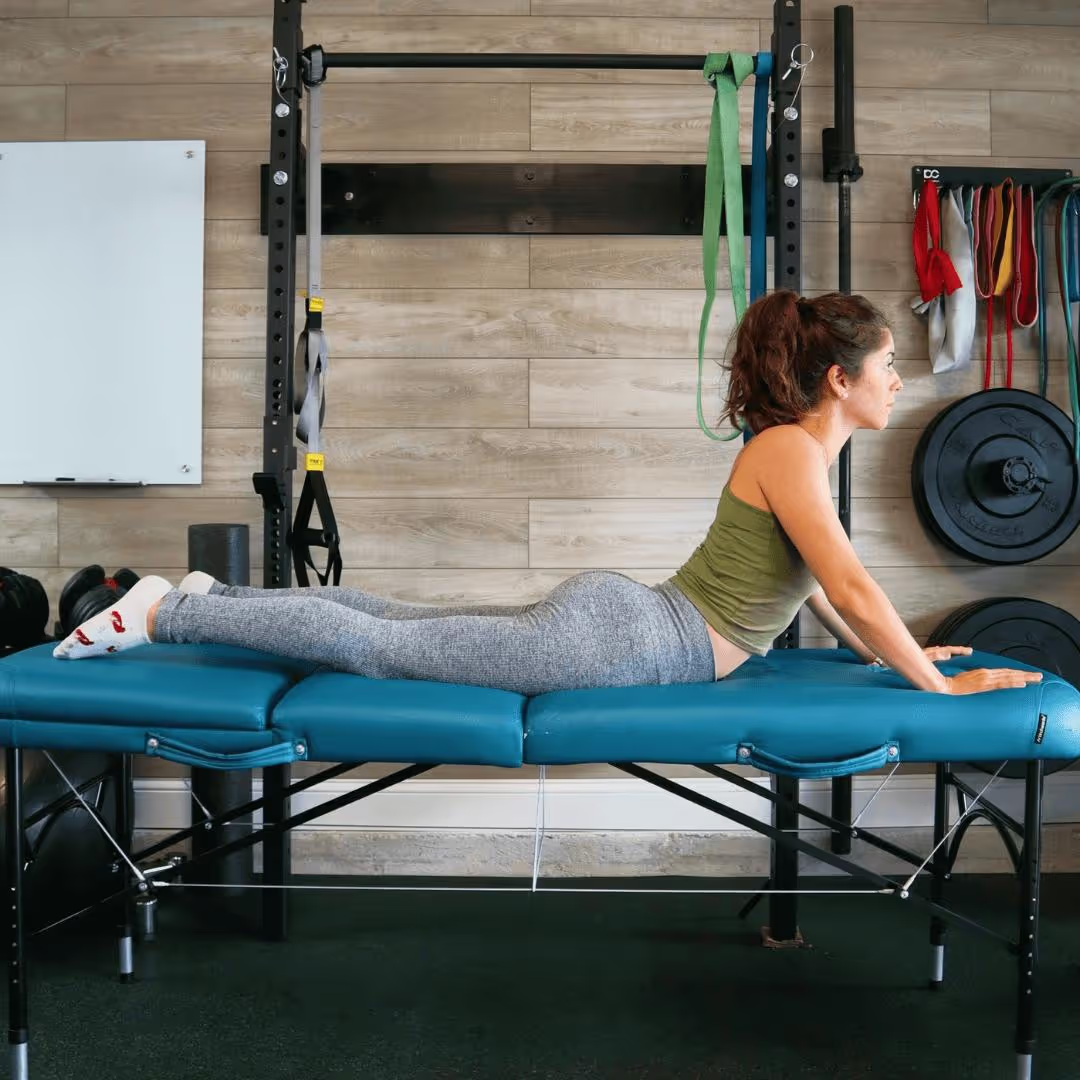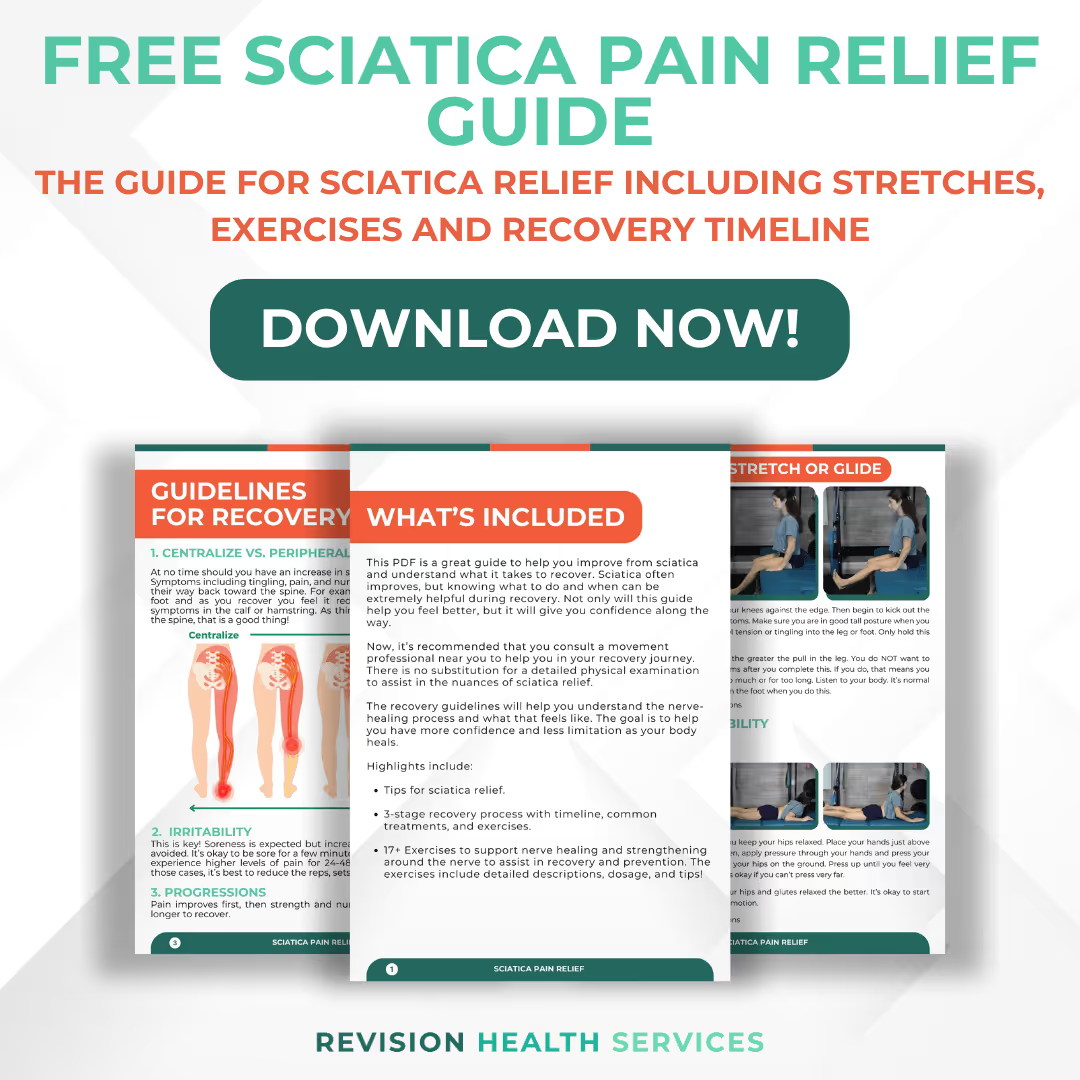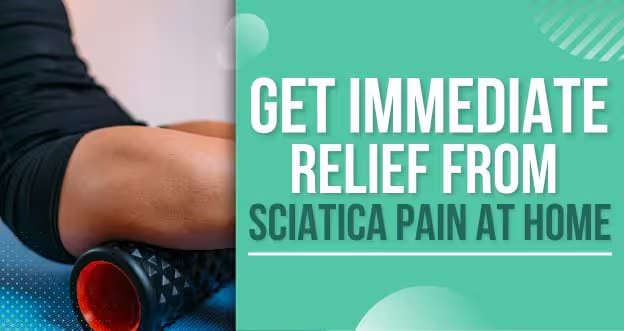
Get Immediate Relief from Sciatica Pain at Home
Recommendations for Immediate Relief For Sciatica Pain at Home
Nerve glides, gentle stretches, and combined movements such as walking are excellent options for immediate relief for sciatica pain from the comfort of your own home. Sometimes, physicians will prescribe medications such as gabapentin or muscle relaxers for patients with back spasms and sciatica. However, other individuals have more mild pain and don't require mediation at all.
Sciatica refers to pain that radiates along the path of the sciatic nerve, which the sciatica nerve originates in the lower back and runs through your buttock, back of the thigh and down your leg. This pain can range from mild discomfort to sharp sensations, often accompanied by sensory changes such as tingling, numbness or burning.
The good news is that you are not alone. Sciatica pain affects millions of people each year and most are better within 4-8 weeks.

Can I Cure My Own Sciatica?
You can certainly cure sciatica on your own using a mix of exercises, stretches, and time, even if it is from a disc herniation or stenosis.
Your body knows how to heal, but your brain can get in the way! Having a movement professional like a physical therapist on your team helps you to understand the signals you are getting from your body. Here are some tips if you would like to try on your own!
Paying attention to how your symptoms react to various activities and knowing when you are improving is key.
Did you know I'm writing a new book on sciatica? It's titled: "Revision Sciatica: The Most Comprehensive Book On Sciatica, Relief, Recovery, and Prevention for Disc Herniations, Stenosis and Leg Pain. Get on the waiting list here to get early access to the book and more FREE sciatica exercises!
4 Tips I Tell My Sciatica Patients To Avoid Makings The Pain Worse:
1. Inactivity can make your symptoms feel worse, so avoid laying around or staying in any static position (especially sitting).
2. Sitting on a soft couch or chair can be very uncomfortable.
3. Picking up heavy objects or doing too much can make your pain linger.
4. Avoid any other aggravating activities that send the pain further down your leg (pain peripheralization).

5 Essentials to Curing Sciatica Permanently At Home
I wish there was some sort of hat trick to make this a reality, but there isn't. Back pain and sciatica are incredibly common and nearly 90% of the time they get better on their own! But for the other 10%, here is what you need to do!
- Stay moving: Elevate your heart rate through activity for up to 150 minutes a week and strength train two days. Balance that with eating plenty of fruits and vegetables and limit processed foods. If you are looking for a guarantee relating to your sciatica, I guarantee making those things into habits will make your body more resilient than it is today for whatever life throws at you next.
- Utilize a variety of physical therapy exercises and stretches to move and heal the sciatic nerve. You will see these below but they include walking and nerve glides!
- Learn if your pain is coming from sciatica or stenosis. This is an essential video to help you figure that out and the next best steps.
- Learn how to move and heal the nerve. The sciatic nerve is irritated and that is what is causing your nerve pain. Moving it is essential.
- Manage inflammation around the nerve with movement, avoiding aggravating positions, and utilizing medication if needed.
Physical Therapy For Sciatica at Home: Recommended Exercises and Stretches
Overview of Quick Relief Techniques You Can Do At Home!
Walking
Walking helps by maintaining and improving spine mobility, preventing stiffness that can exacerbate pain. Walking also engages the core and lower back muscles, promoting strength and stability, which helps support the spine. Walking is also great for increasing blood flow to the muscles and nerves which reduces inflammation, and facilitating healing.
Regularity is key, so make your walks a daily commitment. 15-30 min a day is enough to achieve results.
Gentle movement is key to healing sciatica pain, and nothing is as easy and accessible as taking a walk.
Prone Lying or Tummy Time
One of the easiest exercises you can do for acute sciatica pain is to lay on your stomach on your bed or couch. This places your lower back in a neutral to a bit of extension position. More often than not, this helps the discomfort move towards your back (centralizing) which is the goal.

Prone Press Up
Once you notice your symptoms starting to move closer to your back with prone lying (or at least aren't moving any further down your leg compared to standing), you can start pushing up onto your arms. At first, you might get to your elbows and hang out there for a few breaths. Eventually, you can progress to arms fully extended. Again, your symptoms should keep moving towards your back and NOT down your leg. If your symptoms are moving down your leg with any of these progressions, you're not quite ready for that advancement yet. Try again in a day or so.

Pelvic Tilting
Lie on your back and gently arch your back off of the surface and return to resting, You can also gently push your back flat into the bed, but this may be aggravating with acute sciatica.

Glute Squeezes
Engaging muscles around your back in a nonpainful way helps to increase blood flow and get some movement into your nervous system without aggravating pain. Lying on your back with your knees bent and gentle squeezing your butt muscles together is a good first step for acute back pain.

How to Stretch Your Sciatic Nerve?
Sciatic flossing is a go to exercise for pain relief. This has helped 100's of my patients. Stretching of your sciatic nerve isn't like muscle but the nerve tissue responds very well to movement. The nerve enjoys movement and the ability to glide within tissues without restrictions. Restrictions are typically caused by inflammation. These glides and flossing exercises serve to restore the mobility of the sciatic nerve, while also reducing its sensitivity to movement.
These glides are an ideal gentle movement exercise, perfectly suited for even the worst bouts of sciatica pain, and can be very effective when done properly. Here's how to try it.
.jpeg)

- Lie on your back with both legs bent at the knees
- Hold the painful leg with both hands around your thigh to support its weight.
- While holding the leg, gently straighten your knee while simultaneously pointing your toes up toward the ceiling until you feel a slight pull.
- Reverse this movement by bending the knee again and pull your toes towards your face.
- Repeat this for a few repetitions, stand up, assess how you feel with the stoplight method below.
.avif)
If this exercise is a green light for you, try to increase the tension on your nervous system by reversing the movement of the ankle.


- While in the same position as in previous exercise, couple knee bending with pointing your toes away.
- Then, couple straightening your knee out while pulling your toes towards your head.
Using An Exercises/Swiss Ball
Another great way relieve sciatica pain at home is with swiss ball exercises. A swiss/exercise ball can be used to decompress the spine where you feel intense pressure or discomfort
Application of Heat and Cold Therapy
In my experience, another effective way to provide some immediate relief for sciatica pain at home is the application of a hot or cold compress.
As you can imagine, heat and ice work in different ways, but in my experience, both can be helpful, so don't be afraid to experiment and see which one gives you greater relief.
The best position to apply heat or cold to your low back (not your leg) is while lying on your stomach.
While you may feel pain in you leg, the origin of your pain is in your back!
This position is not always easily tolerated, and if that's the case for you, sliding a pillow under your belly can provide more comfort.
You'll want to stay in this position for about 20 minutes, so make sure you're comfortable. One caution with using an ice compress: always use it with a layer of fabric, such as a pillowcase or towel, and never apply ice directly to your skin.
Importance of Consistency and Gradual Progression
Now that you have the tools to manage your sciatica pain, let’s talk about consistency and time.
Sciatica pain can come on gradually or suddenly, with irritation and inflammation slowly improving over time until one day you finally start to feel better.
Consistency and time are required to heal the inflamed tissues and provide relief. Don't give up and you can use this FREE Sciatica Pain Relief PDF to help you know when you are improving and when to get help!

Additionally, when exercising, there should always be a gradual increase in activity, allowing the body to adapt to new demands and thus reducing the risk of re-injury. By maintaining a steady and consistent approach, you'll be able to manage your symptoms effectively and return to your normal activities.
How to Relieve Sciatica Pain in Bed
There are easy, gentle exercises in bed to help with back pain especially in the acute phase such as lumbar rotations, glute stretches, child's pose, prayer stretch, and cat camel.
However, getting relief from sciatica pain to try to get some sleep in bed is another conversation. It helps to know what position will give you the most relief.
Try sleeping on your side with a long pillow between your legs (you can also use two smaller pillows overlapping). You want the pillow to extend from the pelvic area all the way down to your feet so there are no open spaces between your legs.
This position puts the least amount of pressure on the sciatic nerve, allowing you to sleep through the night.
How Can I Fix Sciatica Naturally?
If your definition of "naturally" is without medications or surgery, physical therapy is your answer. We are the kings and queens of helping people get back to their lives without needing medications and surgery. Remember most get better on their own, so either give it a couple weeks or team up with a PT to heal faster and learn your body!
Everyone's sciatica is different and the fix for it is truly individualized. However, there are tools and tips that commonly help our patients who have sciatica that you can try that we share here. The finesse of how much/little, how often, at what stage of healing, and how to interpret what your body is telling us in response is the challenging part that a physical therapist can help you with.
Instead of asking how to cure your sciatica permanently, you should be asking how can I make my body more resilient for the next time this comes around? Building a resilient body is the key not only for sciatica but for any injury recovery, disease prevention, and high quality of life.
Best Medicine for Sciatica Pain?
Another option that may be helpful for initial treatment of sciatica pain at home is non-steroidal anti-inflammatory drugs (NSAIDs) if these are typically recommended for you by your physician. If you can't take NSAIDS, Acetaminophen may be an alternative. For severe nerve pain related sciatica I have seen patients take Gabapentin or Neuraptine. However, there isn't a BEST medication and this is a decision between you and your physician.
These medications should always be used as directed and under the direction of a physician. They can offer quick and effective relief of pain by reducing inflammation, increasing your movement and exercise tolerance which are crucial for healing and recovery.
These medications are generally not recommended for long-term use without your doctor's recommendation, but they offer a great way to manage pain in the short term if approved by your physician.
When to Seek Professional Guidance
If after about 4-6 weeks your symptoms still persist despite your consistent effort, it might be necessary to seek professional help.
Some other indicators for seeking professional help are: pain that is worsening or severe, recurrent numbness or tingling sensations in your groin, muscle weakness in the leg or foot, and cauda equina syndrome characterized by the loss of bowel or bladder control. Cauda equina syndrome, although quite rare, is considered a medical emergency and requires immediate medical attention.

You may also wish to seek professional physical therapy for sciatica pain to really get down to the root cause of your symptoms. By identifying and treating the root cause and not just treating the pain, you greatly reduce the risk of another sciatica pain episode in the future. Sciatica pain is often self-limiting, meaning that with time and proper home therapies like those described here, many people experience relief and recovery. As a physical therapist, I’ve seen countless patients improve significantly through these simple interventions.
The professional guidance and education will empower you with the understanding of the risk factors as they relate to lifestyle choices, as well as with the knowledge of the muscle strengthening, mobility and posture exercises, which when done with consistency, can provide long lasting and often permanent relief.
In conclusion, managing sciatica pain at home is entirely possible with consistent, mindful movement and patience. Gentle exercises, like nerve glides, stretching, and walking, can provide relief while promoting healing. Avoiding aggravating activities, such as prolonged sitting or lifting heavy objects, is key to preventing pain from worsening. Remember, recovery takes time. Gradual progression is essential. If symptoms persist or worsen, seeking guidance from a physical therapist can make a significant difference, empowering you to understand and effectively manage your condition.
Recommendations for Immediate Relief For Sciatica Pain at Home
Nerve glides, gentle stretches, and combined movements such as walking are excellent options for immediate relief for sciatica pain from the comfort of your own home. Sometimes, physicians will prescribe medications such as gabapentin or muscle relaxers for patients with back spasms and sciatica. However, other individuals have more mild pain and don't require mediation at all.
Sciatica refers to pain that radiates along the path of the sciatic nerve, which the sciatica nerve originates in the lower back and runs through your buttock, back of the thigh and down your leg. This pain can range from mild discomfort to sharp sensations, often accompanied by sensory changes such as tingling, numbness or burning.
The good news is that you are not alone. Sciatica pain affects millions of people each year and most are better within 4-8 weeks.

Can I Cure My Own Sciatica?
You can certainly cure sciatica on your own using a mix of exercises, stretches, and time, even if it is from a disc herniation or stenosis.
Your body knows how to heal, but your brain can get in the way! Having a movement professional like a physical therapist on your team helps you to understand the signals you are getting from your body. Here are some tips if you would like to try on your own!
Paying attention to how your symptoms react to various activities and knowing when you are improving is key.
Did you know I'm writing a new book on sciatica? It's titled: "Revision Sciatica: The Most Comprehensive Book On Sciatica, Relief, Recovery, and Prevention for Disc Herniations, Stenosis and Leg Pain. Get on the waiting list here to get early access to the book and more FREE sciatica exercises!
4 Tips I Tell My Sciatica Patients To Avoid Makings The Pain Worse:
1. Inactivity can make your symptoms feel worse, so avoid laying around or staying in any static position (especially sitting).
2. Sitting on a soft couch or chair can be very uncomfortable.
3. Picking up heavy objects or doing too much can make your pain linger.
4. Avoid any other aggravating activities that send the pain further down your leg (pain peripheralization).

5 Essentials to Curing Sciatica Permanently At Home
I wish there was some sort of hat trick to make this a reality, but there isn't. Back pain and sciatica are incredibly common and nearly 90% of the time they get better on their own! But for the other 10%, here is what you need to do!
- Stay moving: Elevate your heart rate through activity for up to 150 minutes a week and strength train two days. Balance that with eating plenty of fruits and vegetables and limit processed foods. If you are looking for a guarantee relating to your sciatica, I guarantee making those things into habits will make your body more resilient than it is today for whatever life throws at you next.
- Utilize a variety of physical therapy exercises and stretches to move and heal the sciatic nerve. You will see these below but they include walking and nerve glides!
- Learn if your pain is coming from sciatica or stenosis. This is an essential video to help you figure that out and the next best steps.
- Learn how to move and heal the nerve. The sciatic nerve is irritated and that is what is causing your nerve pain. Moving it is essential.
- Manage inflammation around the nerve with movement, avoiding aggravating positions, and utilizing medication if needed.
Physical Therapy For Sciatica at Home: Recommended Exercises and Stretches
Overview of Quick Relief Techniques You Can Do At Home!
Walking
Walking helps by maintaining and improving spine mobility, preventing stiffness that can exacerbate pain. Walking also engages the core and lower back muscles, promoting strength and stability, which helps support the spine. Walking is also great for increasing blood flow to the muscles and nerves which reduces inflammation, and facilitating healing.
Regularity is key, so make your walks a daily commitment. 15-30 min a day is enough to achieve results.
Gentle movement is key to healing sciatica pain, and nothing is as easy and accessible as taking a walk.
Prone Lying or Tummy Time
One of the easiest exercises you can do for acute sciatica pain is to lay on your stomach on your bed or couch. This places your lower back in a neutral to a bit of extension position. More often than not, this helps the discomfort move towards your back (centralizing) which is the goal.

Prone Press Up
Once you notice your symptoms starting to move closer to your back with prone lying (or at least aren't moving any further down your leg compared to standing), you can start pushing up onto your arms. At first, you might get to your elbows and hang out there for a few breaths. Eventually, you can progress to arms fully extended. Again, your symptoms should keep moving towards your back and NOT down your leg. If your symptoms are moving down your leg with any of these progressions, you're not quite ready for that advancement yet. Try again in a day or so.

Pelvic Tilting
Lie on your back and gently arch your back off of the surface and return to resting, You can also gently push your back flat into the bed, but this may be aggravating with acute sciatica.

Glute Squeezes
Engaging muscles around your back in a nonpainful way helps to increase blood flow and get some movement into your nervous system without aggravating pain. Lying on your back with your knees bent and gentle squeezing your butt muscles together is a good first step for acute back pain.

How to Stretch Your Sciatic Nerve?
Sciatic flossing is a go to exercise for pain relief. This has helped 100's of my patients. Stretching of your sciatic nerve isn't like muscle but the nerve tissue responds very well to movement. The nerve enjoys movement and the ability to glide within tissues without restrictions. Restrictions are typically caused by inflammation. These glides and flossing exercises serve to restore the mobility of the sciatic nerve, while also reducing its sensitivity to movement.
These glides are an ideal gentle movement exercise, perfectly suited for even the worst bouts of sciatica pain, and can be very effective when done properly. Here's how to try it.
.jpeg)

- Lie on your back with both legs bent at the knees
- Hold the painful leg with both hands around your thigh to support its weight.
- While holding the leg, gently straighten your knee while simultaneously pointing your toes up toward the ceiling until you feel a slight pull.
- Reverse this movement by bending the knee again and pull your toes towards your face.
- Repeat this for a few repetitions, stand up, assess how you feel with the stoplight method below.
.avif)
If this exercise is a green light for you, try to increase the tension on your nervous system by reversing the movement of the ankle.


- While in the same position as in previous exercise, couple knee bending with pointing your toes away.
- Then, couple straightening your knee out while pulling your toes towards your head.
Using An Exercises/Swiss Ball
Another great way relieve sciatica pain at home is with swiss ball exercises. A swiss/exercise ball can be used to decompress the spine where you feel intense pressure or discomfort
Application of Heat and Cold Therapy
In my experience, another effective way to provide some immediate relief for sciatica pain at home is the application of a hot or cold compress.
As you can imagine, heat and ice work in different ways, but in my experience, both can be helpful, so don't be afraid to experiment and see which one gives you greater relief.
The best position to apply heat or cold to your low back (not your leg) is while lying on your stomach.
While you may feel pain in you leg, the origin of your pain is in your back!
This position is not always easily tolerated, and if that's the case for you, sliding a pillow under your belly can provide more comfort.
You'll want to stay in this position for about 20 minutes, so make sure you're comfortable. One caution with using an ice compress: always use it with a layer of fabric, such as a pillowcase or towel, and never apply ice directly to your skin.
Importance of Consistency and Gradual Progression
Now that you have the tools to manage your sciatica pain, let’s talk about consistency and time.
Sciatica pain can come on gradually or suddenly, with irritation and inflammation slowly improving over time until one day you finally start to feel better.
Consistency and time are required to heal the inflamed tissues and provide relief. Don't give up and you can use this FREE Sciatica Pain Relief PDF to help you know when you are improving and when to get help!

Additionally, when exercising, there should always be a gradual increase in activity, allowing the body to adapt to new demands and thus reducing the risk of re-injury. By maintaining a steady and consistent approach, you'll be able to manage your symptoms effectively and return to your normal activities.
How to Relieve Sciatica Pain in Bed
There are easy, gentle exercises in bed to help with back pain especially in the acute phase such as lumbar rotations, glute stretches, child's pose, prayer stretch, and cat camel.
However, getting relief from sciatica pain to try to get some sleep in bed is another conversation. It helps to know what position will give you the most relief.
Try sleeping on your side with a long pillow between your legs (you can also use two smaller pillows overlapping). You want the pillow to extend from the pelvic area all the way down to your feet so there are no open spaces between your legs.
This position puts the least amount of pressure on the sciatic nerve, allowing you to sleep through the night.
How Can I Fix Sciatica Naturally?
If your definition of "naturally" is without medications or surgery, physical therapy is your answer. We are the kings and queens of helping people get back to their lives without needing medications and surgery. Remember most get better on their own, so either give it a couple weeks or team up with a PT to heal faster and learn your body!
Everyone's sciatica is different and the fix for it is truly individualized. However, there are tools and tips that commonly help our patients who have sciatica that you can try that we share here. The finesse of how much/little, how often, at what stage of healing, and how to interpret what your body is telling us in response is the challenging part that a physical therapist can help you with.
Instead of asking how to cure your sciatica permanently, you should be asking how can I make my body more resilient for the next time this comes around? Building a resilient body is the key not only for sciatica but for any injury recovery, disease prevention, and high quality of life.
Best Medicine for Sciatica Pain?
Another option that may be helpful for initial treatment of sciatica pain at home is non-steroidal anti-inflammatory drugs (NSAIDs) if these are typically recommended for you by your physician. If you can't take NSAIDS, Acetaminophen may be an alternative. For severe nerve pain related sciatica I have seen patients take Gabapentin or Neuraptine. However, there isn't a BEST medication and this is a decision between you and your physician.
These medications should always be used as directed and under the direction of a physician. They can offer quick and effective relief of pain by reducing inflammation, increasing your movement and exercise tolerance which are crucial for healing and recovery.
These medications are generally not recommended for long-term use without your doctor's recommendation, but they offer a great way to manage pain in the short term if approved by your physician.
When to Seek Professional Guidance
If after about 4-6 weeks your symptoms still persist despite your consistent effort, it might be necessary to seek professional help.
Some other indicators for seeking professional help are: pain that is worsening or severe, recurrent numbness or tingling sensations in your groin, muscle weakness in the leg or foot, and cauda equina syndrome characterized by the loss of bowel or bladder control. Cauda equina syndrome, although quite rare, is considered a medical emergency and requires immediate medical attention.

You may also wish to seek professional physical therapy for sciatica pain to really get down to the root cause of your symptoms. By identifying and treating the root cause and not just treating the pain, you greatly reduce the risk of another sciatica pain episode in the future. Sciatica pain is often self-limiting, meaning that with time and proper home therapies like those described here, many people experience relief and recovery. As a physical therapist, I’ve seen countless patients improve significantly through these simple interventions.
The professional guidance and education will empower you with the understanding of the risk factors as they relate to lifestyle choices, as well as with the knowledge of the muscle strengthening, mobility and posture exercises, which when done with consistency, can provide long lasting and often permanent relief.
In conclusion, managing sciatica pain at home is entirely possible with consistent, mindful movement and patience. Gentle exercises, like nerve glides, stretching, and walking, can provide relief while promoting healing. Avoiding aggravating activities, such as prolonged sitting or lifting heavy objects, is key to preventing pain from worsening. Remember, recovery takes time. Gradual progression is essential. If symptoms persist or worsen, seeking guidance from a physical therapist can make a significant difference, empowering you to understand and effectively manage your condition.




%20Blog%20thumbnails%204.avif)
